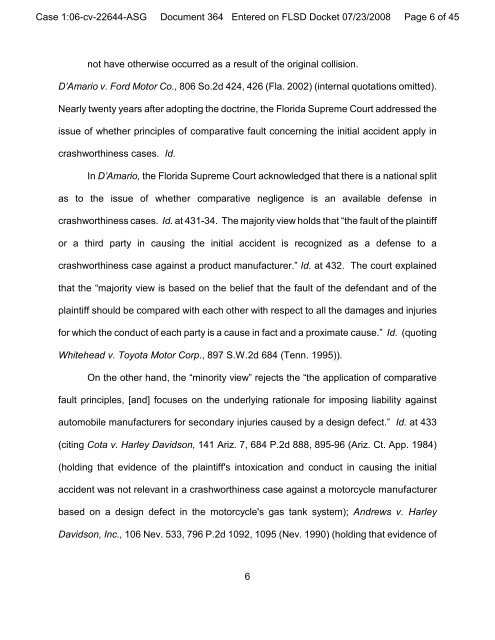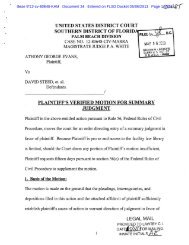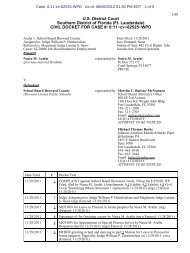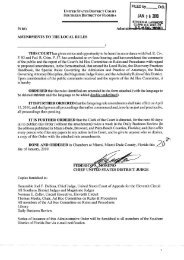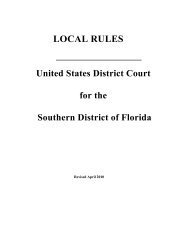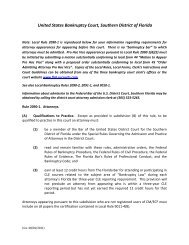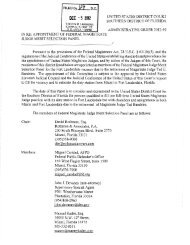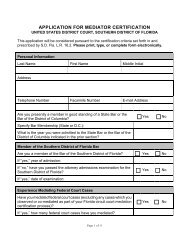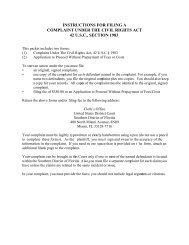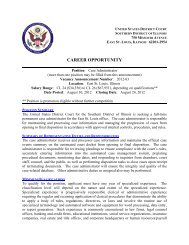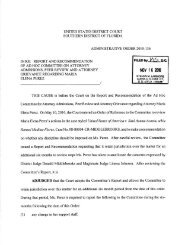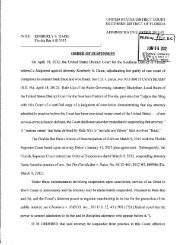Motion in Limine - United States District Court
Motion in Limine - United States District Court
Motion in Limine - United States District Court
You also want an ePaper? Increase the reach of your titles
YUMPU automatically turns print PDFs into web optimized ePapers that Google loves.
Case 1:06-cv-22644-ASG Document 364 Entered on FLSD Docket 07/23/2008 Page 6 of 45<br />
not have otherwise occurred as a result of the orig<strong>in</strong>al collision.<br />
D’Amario v. Ford Motor Co., 806 So.2d 424, 426 (Fla. 2002) (<strong>in</strong>ternal quotations omitted).<br />
Nearly twenty years after adopt<strong>in</strong>g the doctr<strong>in</strong>e, the Florida Supreme <strong>Court</strong> addressed the<br />
issue of whether pr<strong>in</strong>ciples of comparative fault concern<strong>in</strong>g the <strong>in</strong>itial accident apply <strong>in</strong><br />
crashworth<strong>in</strong>ess cases. Id.<br />
In D’Amario, the Florida Supreme <strong>Court</strong> acknowledged that there is a national split<br />
as to the issue of whether comparative negligence is an available defense <strong>in</strong><br />
crashworth<strong>in</strong>ess cases. Id. at 431-34. The majority view holds that “the fault of the pla<strong>in</strong>tiff<br />
or a third party <strong>in</strong> caus<strong>in</strong>g the <strong>in</strong>itial accident is recognized as a defense to a<br />
crashworth<strong>in</strong>ess case aga<strong>in</strong>st a product manufacturer.” Id. at 432. The court expla<strong>in</strong>ed<br />
that the “majority view is based on the belief that the fault of the defendant and of the<br />
pla<strong>in</strong>tiff should be compared with each other with respect to all the damages and <strong>in</strong>juries<br />
for which the conduct of each party is a cause <strong>in</strong> fact and a proximate cause.” Id. (quot<strong>in</strong>g<br />
Whitehead v. Toyota Motor Corp., 897 S.W.2d 684 (Tenn. 1995)).<br />
On the other hand, the “m<strong>in</strong>ority view” rejects the “the application of comparative<br />
fault pr<strong>in</strong>ciples, [and] focuses on the underly<strong>in</strong>g rationale for impos<strong>in</strong>g liability aga<strong>in</strong>st<br />
automobile manufacturers for secondary <strong>in</strong>juries caused by a design defect.” Id. at 433<br />
(cit<strong>in</strong>g Cota v. Harley Davidson, 141 Ariz. 7, 684 P.2d 888, 895-96 (Ariz. Ct. App. 1984)<br />
(hold<strong>in</strong>g that evidence of the pla<strong>in</strong>tiff's <strong>in</strong>toxication and conduct <strong>in</strong> caus<strong>in</strong>g the <strong>in</strong>itial<br />
accident was not relevant <strong>in</strong> a crashworth<strong>in</strong>ess case aga<strong>in</strong>st a motorcycle manufacturer<br />
based on a design defect <strong>in</strong> the motorcycle's gas tank system); Andrews v. Harley<br />
Davidson, Inc., 106 Nev. 533, 796 P.2d 1092, 1095 (Nev. 1990) (hold<strong>in</strong>g that evidence of<br />
6


